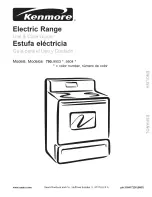
18
Stainless Steel Surfaces
CAUTION
To prevent damage, wipe stainless steel surfaces only in
the direction of the grain.
The outside surfaces of the range are covered with
stainless steel. Clean these surfaces with Dacor
Stainless Steel Cleaner (see page 23 to reorder).
Rinse and dry with a soft, lint-free cloth. Always
wipe stainless steel surfaces with the grain. A small
amount of baby oil may be applied to stainless steel
tops to restore lustre.
Brass, Chrome and Copper Surfaces
Clean brass, chrome and copper surfaces the same
way as stainless steel surfaces (see column one).
Door Glass
Clean all glass surfaces with a solution of mild
detergent and hot water. Use a mild glass cleaner to
remove fingerprints or smears. Dry completely with
a soft, lint-free cloth.
Griddle
Clean the griddle after each use. Wash it thoroughly
in hot soapy water to avoid stains from grease
build-up. The griddle is coated with a non-stick coat-
ing for easy cleaning. Warm water and liquid deter-
gent are all that are needed for cleaning. Remove
stubborn spots with a non-abrasive plastic mesh
pad. To prevent scratching, do not use abrasives or
abrasive cleaners. Use the soft side of a sponge to
scrub it. Dry it with a lint-free cloth.
IR (Infrared) Broil Burner
WARNING
To prevent damage to the broil burner, do not spray the
burner or its igniter with any type of cleaner or attempt to
scrub them in any manner.
The IR broil burner is self-cleaning. To burn off any
grime build-up, close the oven door and turn the
oven control knob to the
BROIL
position for about
ten minutes. After ten minutes turn the oven off.
Care and Cleaning
Cooktop Cleaning (cont.)
Cleaning the Igniters and Other Burner
Components
WARNING
Use care while cleaning the igniters. The porcelain is
fragile and can crack or break.
IMPORTANT
: The igniters will not work properly
if the burner rings, burner bases or igniters are not
clean. Dirty or wet igniters may not spark at all.
After disassembling the burners, check for any dirt
or grime deposited on the individual parts, including
the igniters.
1. Clean completely around the igniter, including the
metal top and porcelain base. A firm toothbrush
is ideal for this task. Use care while cleaning
because the porcelain is fragile and can crack or
break. Do not use water to clean the igniters. If
necessary, use a small amount of rubbing alcohol
to help dissolve grime.
2. Examine the burner rings. Remove anything
stuck in the holes with a straightened paper
clip, wire or needle. Be careful not to scratch or
damage it. Do not distort the shape of the holes.
3. Clean all the burner rings, with window cleaner or
rubbing alcohol. Use a cleaning brush with plastic
bristles or a firm tooth brush. When done, rinse
the parts well with clean water. Dry all the parts
thoroughly before re-assembling them.
4. Clean the burner caps with a solution of mild
detergent and hot water.
5. Reassemble the cooktop in the reverse order (see
page 6 for detailed instructions). Make sure
you line up the notches on the burner rings.
6. Re-connect the power cord and test the burners
after reassembling them. If the flame is uneven,
be sure that all the burner parts are properly
positioned, then check for any remaining dirt or
grime on the burner parts or igniter. If erratic
clicking is still present, make sure the igniter is
completely dry. If the unit still exhibits problems
after drying, call your local Dacor authorized ser-
vice agent.
Porcelain Surfaces
• The oven interior, the inner side of the oven
door and the spill tray are finished in porcelain
enamel.
• Clean porcelain surfaces with a solution of mild
detergent and hot water. Rinse and dry with a
soft cloth. Do not use abrasives or commercial
oven cleaners. You may remove the rack sup-
ports to clean the surfaces behind them more
easily.
Содержание Renaissance RNRP36GSNGH
Страница 2: ...2014 Dacor all rights reserved...









































